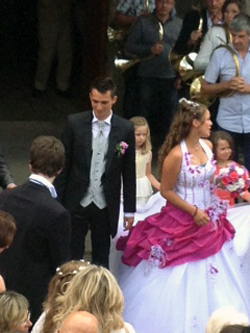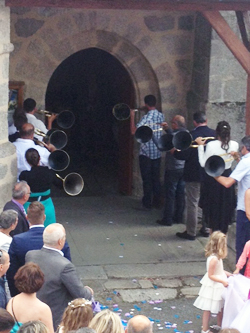By Dorothea Shefer-Vanson


DOMEYROT, France — The house where we are staying in the French countryside is opposite the village church, a not very imposing edifice dating from the late seventeenth century. Many of the other churches in the region are from the twelfth, thirteenth and even ninth centuries and seem to have stood the test of time quite well, though much of the original artwork has been eroded by time or removed by ungodly hands.
We had been informed in advance that a wedding was to be celebrated there one afternoon, and were asked to park our car elsewhere on that day, with which request we duly complied.
A wedding in an almost deserted French village is a rare event, to say the least. Most of the inhabitants of rural France are old-timers whose livelihoods were not dependent on the contemporary labor market. They live reasonably well on their pensions, but it is funerals that are a more common occurrence than weddings in this part of the world. This is partly due to the scarcity of employment for young people in the region, and also to the wholesale slaughter of many young men in the First World War. There isn’t a village in the area that doesn’t have a WWI memorial at the center with a long list of names of the fallen. Many houses are boarded up and deserted, falling into disrepair for lack of anyone to see to their upkeep,
So a wedding is an event to be savored. The guests for this one started arriving in good time, and the usually deserted church square witnessed more activity than it had for many a day. The inhabitants of this part of the world are not what one might call smart dressers, so it was a pleasant surprise to see well-turned out ladies and gents, who had obviously made an effort to look their best (or come from elsewhere). At the appointed hour the church bells began to peal, and the bride and her entourage emerged from her home, at the other end of a small lane, known as ‘Lovers’ Lane,’ which leads straight to the church.
The weather was perfect, the sun was shining but not too hot, and everything seemed to be falling into place for the occasion. The bride looked very young and pretty as she approached, but had a worried look on her face, which made me wonder if her shoes weren’t hurting her or whether she wasn’t contemplating making a bolt for it. But there was no chance of that as she was surrounded by her large and evidently loving family.
As she approached the church the throng outside stood aside and the priest, who was also wearing a long white but less frilly gown, stood at the entrance to welcome her. After an hour or so while everyone was inside the church the bells began to peal again, the people gathered outside to await the emergence of the now-married young people. If anything, the bridegroom looked even younger than the bride, and my guess is that they were both teenagers or thereabouts.

But then came the surprise that pretty much knocked my socks off. An ensemble of eight musicians, all playing trombons-chasse (a hunting trombone), whichlooked like a highly-polished and antique version of the bugle (I would have expected a French horn), stood in formation in the church vestibule, four on each side, and played one fanfare after another as the bride and groom came out. They continued playing as the young couple embarked on the customary round of kissing and congratulations once the official ceremony was over and before everyone (presumably) trooped off for the festive meal.
The ensemble continued to play for about half an hour, though whether those were traditional French songs or special wedding fanfares they were playing I couldn’t say. All I can say is that both visually and audially it was an impressive performance. Even more impressive was the fact that two of the players were women (you need a lot of puff to play a valveless brass instrument). The bugles seemed to have larger horns than anything I’ve managed to find on the internet, and I noted with amusement that the players had to stand with their backs to the audience to enable the sound to reach them. Then they all raised their instruments up high above their heads to form an honor guard, as it were, or perhaps to show the objects on which they had displayed their proficiency.
Understandably enough, the bride seemed happier and more relaxed after the ceremony, and as she turned among the guests I was able to examine her dress more closely. She wore the traditional meringue-style puffy white dress, but the magenta trimming and draped segment that covered her posterior were not to my taste. But then, what do I know of what’s ‘in’ in French village weddings these days? The main thing is that they should only be happy and healthy and have lots of lovely little French babies.
*
Shefer-Vanson is an author and freelance writer based in the Jerusalem suburb of Mevasseret Zion, Israel. You may comment to her at dorothea.shefer@sdjewishworld.com